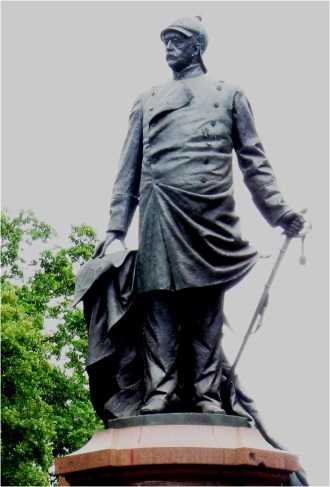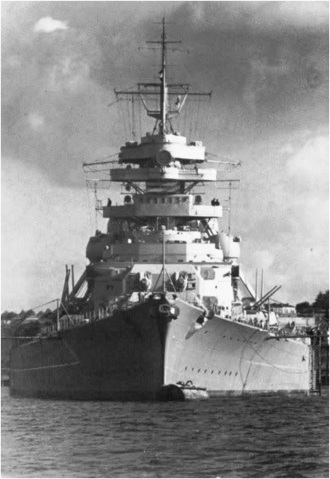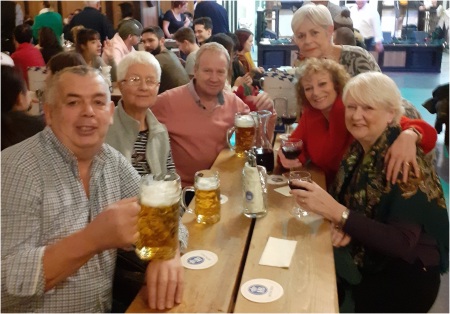“Where some states have an army, the Prussian Army has a state.” –
After a few stops we left the train and walked through the Tiergarten. This was once a Royal hunting forest but was cut down for firewood during the immediate post war period when fuel was in short supply and has now been replanted as a very fine public park.
Late afternoon and it was beginning to get dark. The park is nice but a bit edgy with little gangs of dangerous looking men and we witnessed at least two dodgy transactions – drugs we imagined. To be on the safe side we stayed on the well lit footpaths and didn’t risk the shadows of the woodland tracks.
Berlin was once the capital city of Prussia and then Germany after 1871.
Prussia had become a modern European State in 1701 and for the next one hundred and seventy years was at war with someone or another for a total of ninety years, or over half of its existence. Not surprisingly Prussia was seen as a militaristic threat to the stability of Europe and so was abolished by the victorious allies in 1947. This wasn’t especially difficult, two years earlier the Russian offensive in the Battle of Berlin had demolished and removed almost all Prussian heritage. East Prussia was absorbed into a redefined Poland and the remainder became East Germany.
As a consequence Berlin has little history. The entire city by necessity is modern, it has only been rebuilt over the last seventy-five years so is quite contemporary and lacks charm. There are no grand palaces, cathedrals, stately homes or castles because they have all been swept away. Even the trams are brand-spanking new. A lot of central and eastern European cities continue to preserve fifty year old vehicles but not so in Berlin.
It is as though Germany doesn’t want to recognise its short and unhappy existence which after all has included a belligerent monarchy, an economic crisis, a failed republic and a totalitarian dictator.
Not really surprising then that Germany looks mostly to the future. In 2003 in a television poll German viewers bypassed Otto Von Bismarck (voting for Adolf Hitler was not allowed) and voted post-war Chancellor Konrad Adenauer as the greatest German of all time. Hands up anyone who has heard of Konrad Adenauer? It would be like voting Theresa May as the Greatest Briton. I mention this now just as a comparison, if you think Adenauer is an odd choice, in a similar poll in the USA they voted Ronald Reagan the Greatest American!
Back to Germany – Reformation monk Martin Luther came second, with communist philosopher Karl Marx third.
Another feature that I noticed that makes Berlin stand out against other grand European cities is that it has very few statues; it is that history thing again, Berlin can’t very well have statues of Kaiser Wilhelm II or Adolf Hitler because they were both responsible for unleashing hell in Europe. I understand that there is a statue of the greatest German, Konrad Adenauer but this is some way out of the city centre on the edge of Charlottenburg and we didn’t get to see it. It seems that they are not so proud of him either.
To some extent this is explained by Germany’s post war efforts to confront its past. It took Germans some time to learn this after the second world war, but they finally invented a concept for it: Vergangenheitsaufarbeitung, which translates as “working off the past”.
Midway along the Tiergarten we did eventually come across a famous monument, the Berlin Victory Column, commissioned in 1864 to commemorate the Prussian victory in the Danish-Prussian War and later dedicated also to victory in the 1866 Austro-Prussian War and then the Franco-Prussian War of 1870-71. Prussia did like going to war it seems. It is indeed a grand column that soars into the sky and at the very top stands a golden statue of the Roman God Victory.
Even though it was getting mid Winter late and the light was fading we paid the entrance fee and climbed the two hundred and thirty steps to the top and were rewarded with good views from the observation deck.
Nearby we found a statue of a man that I was expecting to find – Otto Von Bismarck, the architect of modern Germany who was responsible for the creation of the country in 1871 following the defeat of France in a short-sharp war – the sort of quick victory Germany expected again in 1914. The sort of victory, it has to be said, that Great Britain also anticipated. A grand statue but not on prominent display but instead tucked discreetly inside a corner of the Tiergarten adjacent to the Victory Column.
In the USA there are Towns and cities called Bismarck in Arkansas, Illinois, Michegan, Minnesota, Missouri, Nebraska, North Dakota (The State Capital*) and West Virginia. As far as I am aware there are no towns or cities called Adenauer.
I would have really expected Bismarck to have been voted the ‘Greatest German’ but it seems that for many he is too closely associated with establishing a Teutonic military regime based on Prussian aggression which led directly to two European villains, two World Wars and the biggest battleship ever in the German Navy and the largest in any European fleet in World-War-Two.
What a beast…
After walking the entire length of the Tiergarten we returned by a different path and made our way back to Alexanderplatz where we finished our ten mike walk (a distance we hadn’t really anticipated at breakfast) with a well earned beer and a glass of wine close to our hotel.
* Bismarck was named after the Prussian statesman in an attempt to attract German investors to the Northern Pacific Railroad, for which Bismarck served as terminus. While the bid for investors was unsuccessful, Otto sent the railroad an autographed note of acknowledgement.








Some of those missing statues still exist. They have been dusted off, painted a ghostly white and are displayed against a white background at the Citadel of Berlin-Spandau, in a permanent exhibition called “Unveiled. Berlin and its Monuments”, which shows “political monuments which were once part of Berlin’s urban landscape but have been removed.”
https://operasandcycling.com/berlin-citadel-with-discarded-statues/
LikeLiked by 2 people
Thank you for the information and the link.
LikeLiked by 1 person
So interesting!
LikeLiked by 1 person
There is a park in Riga in Latvia which has all of the old statues of the communist east.
LikeLiked by 1 person
Lovely photos. I enjoyed visiting Berlin when I was young and hope to go back!
LikeLike
It is a good city to visit for sure!
LikeLike
Love the history lesson.. Thank YOU 😉
LikeLike
Thanks for reading it!
LikeLike
A fine analysis. What price Boris as the greatest Englishman one day?
LikeLike
The bottom line is that in the UK it was a pointless exercise, Churchill was always going to win hands down and would do so again if they repeated the exercise.
This is my full post on the Greatest Briton…
LikeLiked by 1 person
Thanks a lot, Andrew. I enjoyed the link and have added one for you.
LikeLike
Really enjoyed reading this post. Well written and very interesting from the point of view of someone whose family comes from the eastern parts of Prussia. Thanks!
LikeLike
Thanks for stopping by. I have always been fascinated by the history of Prussia.
LikeLike
exactly no charm and sad stories….
LikeLike
But still a great city and well worth a visit. Great history and I am a historian!
LikeLiked by 1 person
for the history yes but he dark side. There are many other better cities in Europe even in Germany.
LikeLike
Your recommendations?
LikeLike
LikeLike
Putting my hand up to having heard of Adenauer, but I have no idea what he looked like so wouldn’t recognise his statue if I came across it. Bismarck on the other hand, pursued me through O-level, A-level, and BA History. Couldn’t get away from him!
LikeLiked by 1 person
Same for me Anabel and I own up to always having had an admiration for him. The Unification of Germany was a fascinating process. Same with Italy.
LikeLike
Yes, I remember your pursuit of Garibaldi statues!
LikeLiked by 1 person
Ha! The price of naming your city Bismark is getting a note from him. I appreciate this quick review of Prussia and Germany. The modernity of the city of Berlin always struck me as interesting, but I like having the context.
LikeLike
Appreciate the history. My grandfather served as a US volunteer ambulance driver (ala Hemingway) with the French Army and served in the Army of Occupation in Berlin until December 1919. He saw first hand the result of Kaiser Wilhelm.
LikeLike
Thanks for adding your contribution to the post.
LikeLike
We have traveled to Germany many times over the years but had never been to Berlin. I would go back in a heartbeat. The city has some of the best museums I’ve been to. I’m looking forward to where your travels will take you this year.
LikeLike
I need to visit the museums. Maybe later this year!
LikeLike
If you do, the Roman Gate and the Ishtar Gate of Babylon At The Pergamon Museum are amazing. We got tickets through the concierge at our hotel and bypassed the very long lines for each of the museums…be sure to do that if you go.
LikeLike
Thanks for the tips!
LikeLiked by 1 person
Reblogged this on THE FLENSBURG FILES.
LikeLike